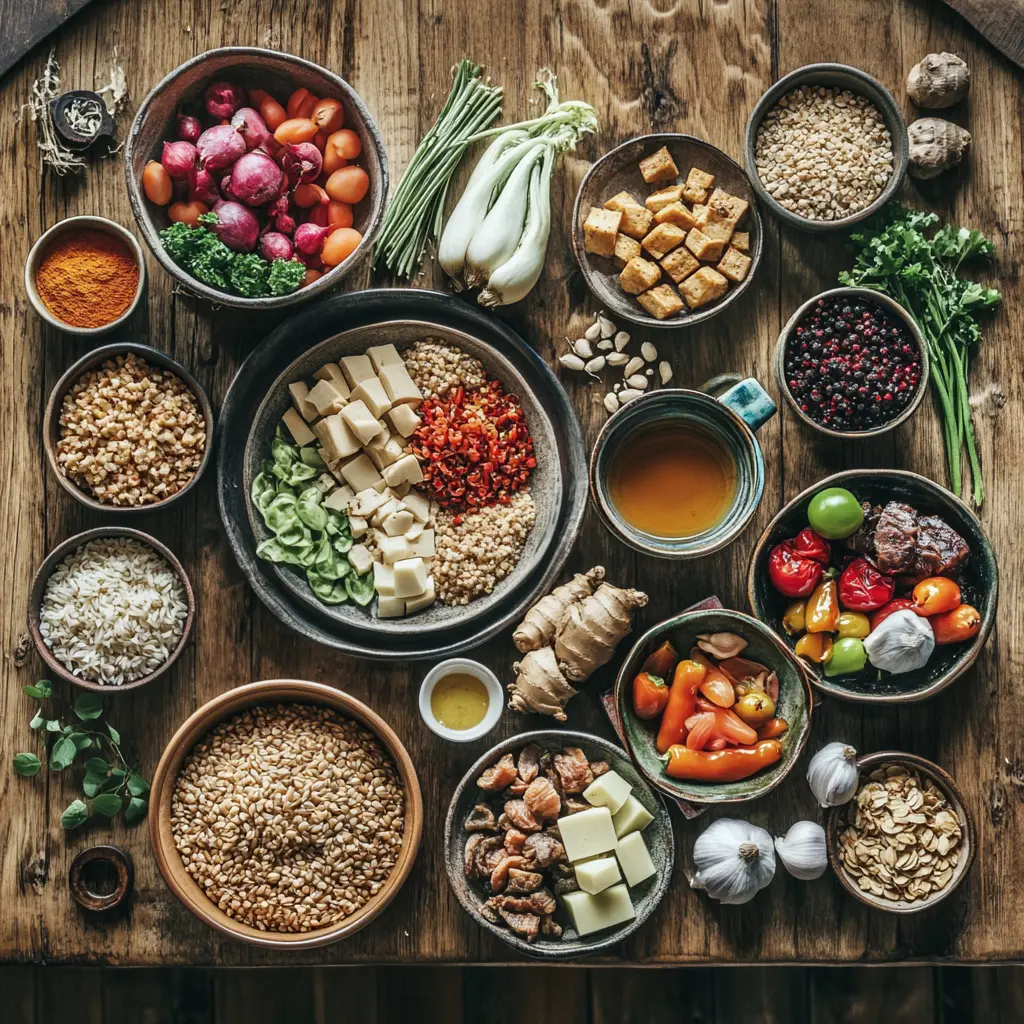The phrase “six classics of food” refers to ancient culinary systems that classify food based on cultural, nutritional, and philosophical frameworks. This concept dates back thousands of years, with roots in traditional Chinese dietary therapy, Confucian philosophy, Ayurvedic practice, and global agricultural history.
In today’s world, understanding the six foundational food categories offers more than historical insight — it can help you build balanced meals that reflect centuries of culinary tradition. In this article, we’ll explore how the six classics — grains, vegetables, fruits, meat, beverages, and condiments — shape how we eat today.
To better understand the importance of balance in a diet, it helps to look at what is considered a healthy dish. These ancient food groups still align closely with today’s nutritional science and help explain how whole foods promote longevity and wellness.
For additional historical context, read about the history of food in ancient civilizations, which explores how these classics were central to survival, ritual, and identity in cultures from Mesopotamia to East Asia.
📚 Historical Origins of the Six Classics
The term “classics of food” originally emerged from traditional Chinese medical texts and Confucian writings that emphasized food as a medium of balance, harmony, and healing. Similar groupings in:
- Ayurveda (India): Classifies food by doshas and elemental properties
- Greek medicine: Tied food to the four humors (blood, phlegm, yellow bile, black bile)
- Indigenous traditions: Balance crops by seasons and ceremonial use
Each system focused on how *whole foods support bodily functions and emotional stability*. Unlike modern food pyramids, these classics aim for **synergy between food groups** — rather than rigid portioning.
🌾 The Six Classics of Food: An Overview
The six food “classics” represent a cross-cultural framework that appears in various culinary traditions. Each category plays a role in achieving physical nourishment and energetic balance.
The Six Are:
1. Grains & Cereals – Base energy sources
2. Vegetables – Essential vitamins and fiber
3. Fruits – Natural sugars and antioxidants
4. Meat & Protein – Building blocks of strength
5. Beverages – Hydration and herbal balance
6. Condiments & Spices – Flavor and medicinal function
These elements are not just *nutritional blocks* — they carry **symbolic, seasonal, and functional** meanings that differ by region. For instance, in ancient China, food was judged by its ability to harmonize *yin and yang*, while in India, ingredients were matched to body types and elemental imbalances.
Modern meals like this street corn chicken rice bowl reflect these timeless elements by combining grains, vegetables, protein, and flavorful toppings.
🌾 1. Grains & Cereals – The Foundation of Civilization
Grains are considered the *first classic* of food due to their agricultural importance and role in the development of stable societies. From ancient Mesopotamia to the Indus Valley, *cereal grains were the core of nourishment and trade*.
Examples of Classic Grains:
- Rice (Asia, Africa)
- Wheat (Middle East, Europe)
- Millet (China, Africa)
- Barley (Egypt, Greece)
- Corn (Americas)
These grains were eaten daily, used in rituals, and even offered to gods. Today, they remain staple carbohydrates and are the base of countless dishes across cultures.
Many ancient dishes — like porridges, flatbreads, and rice bowls — continue to be recreated in modern kitchens and reflect the *foundational role of grains in cultural identity*.
🥬 2. Vegetables – The Core of Wellness
Vegetables provide vital *micronutrients, fiber, and flavor*. Considered the second classic of food, they are often tied to fertility, regeneration, and the seasons.
Popular “Classic” Vegetables in Tradition:
- Spinach – Ancient Persia, Europe
- Radish – China, Japan, Europe
- Beans – Americas, Africa
- Cabbage – Eastern Europe, Korea
- Onion – Egypt, India
These were easy to grow and preserve, making them cornerstones of peasant diets and royal feasts alike. Their diversity, from leafy greens to root vegetables, brought balance to meals in both flavor and function.
Explore similar vegetable-rich dishes in our swamp soup recipe, which showcases classic greens and legumes used for generations.
🍎 3. Fruits – Nature’s Sweet Balance
Fruits were more than snacks in ancient cultures — they symbolized abundance, healing, and seasonal cycles. The third food classic offers natural sugars, antioxidants, and hydration.
Historic Fruits and Their Meaning:
- Figs – Fertility (Greece, Middle East)
- Pomegranate – Life & resurrection (Persia, India)
- Dates – Energy & celebration (Middle East, North Africa)
- Apples – Immortality (Norse mythology, China)
- Citrus – Cleanser & digestion aid (Asia)
Fruits were often dried or fermented for use outside of harvest seasons. They played key roles in medicine, religious rituals, and ancient cosmetics. Their balance of *sweet and tart* was believed to regulate emotions and body temperature.
Even today, fruits anchor many cultural celebrations — from Lunar New Year oranges to Rosh Hashanah apples dipped in honey — echoing their status as timeless food icons.
🍖 4. Meat & Protein – From Sacred Offering to Daily Fuel
The fourth food classic, *meat and protein*, evolved from a luxury for the elite to a nutritional necessity in most global cuisines. Historically, protein was tied to *strength, vitality, and sacrifice* — often reserved for religious festivals or royal banquets.
Classic Proteins in World Cuisine:
- Fish – staple in Asia, Mediterranean
- Lamb – sacred and celebratory in Middle Eastern cultures
- Poultry – affordable, symbolic in Chinese and Jewish food
- Legumes – vegetarian protein in Indian and African cuisines
- Tofu – fermented soybean protein from East Asia
Protein remains central to modern nutrition as it supports muscle, repair, and immune health. Whether plant-based or meat-sourced, it is considered *essential to both spiritual and physical sustenance*.
In many traditional diets, protein was balanced by grains and vegetables to create complete meals — a strategy you can still see in recipes like our street corn chicken rice bowl, which layers multiple classics.
🍵 5. Beverages – Hydration, Ritual, and Restoration
The fifth classic is often overlooked — but *beverages* are central to traditional medicine and ceremony. In ancient and classical civilizations, drinks weren’t just for hydration — they were used for *digestion, healing, and social bonding*.
Iconic Beverages with Cultural Significance:
- Tea: In Chinese, Japanese, and British traditions – used in rituals and healing
- Wine: Symbol of abundance in Greek, Roman, and Christian cultures
- Fermented milk: Kefir and lassi in Middle East, India, Russia
- Broths: Healing tonics in Korean, Chinese, Jewish cuisines
Beverages also mark status and class throughout history.
To explore more, National Geographic discusses how culture shapes our food and drink rituals — highlighting beverages as essential to both spiritual and culinary heritage.
🌶️ 6. Condiments & Spices – The Soul of Flavor
The sixth and final food classic isn’t about bulk nutrition — it’s about *flavor, fermentation, and function*. Condiments and spices transform simple food into regional identity, and many of them were once considered sacred or even used as currency.
Ancient Flavoring Staples:
- Garlic and ginger – Healing roots in Asia and Europe
- Vinegar – Preserving and balancing acidity in ancient dishes
- Soy sauce – Fermented protein flavoring from East Asia
- Chili – Introduced to Asia via trade, now essential in global cuisine
- Salt – Universal preservative, sacred in ancient Rome and India
Spices have had an outsized impact on human history. As explained in the BBC’s feature on how spices shaped the world, trade routes developed around their value, changing the course of global cuisine.
Fermented condiments like kimchi, miso, or hot sauces also support *gut health* and food safety — proving the classics were practical, not just flavorful.
⚖️ The Harmony of the Six – Philosophy Meets Cuisine
What makes these six categories “classic” is their synergy. They weren’t designed to be eaten separately — they were structured to work together as a *nutritional and spiritual system*.
Examples of Philosophical Balance in Food:
- Yin-Yang (China): Cooling vs. warming foods for energy balance
- Ayurveda (India): Balancing sweet, salty, sour, bitter, pungent, and astringent tastes
- Mediterranean cuisine: Balanced grains, olive oil, vegetables, and fish for heart health
By combining foods across these six categories, ancient people intuitively built meals that met macronutrient needs, supported digestion, and enhanced immunity — long before modern science could explain it.
Today, even in high-end kitchens, chefs unconsciously follow these principles. Balanced dishes use at least four of the six categories — a nod to *timeless culinary logic*.
🌿 Applying the Six Classics to Modern Cooking
So how do you apply this concept in everyday life? By learning to see meals as a *culinary composition*, not just calories.
Simple Meal Ideas Using the Six Classics:
- Brown rice (grain) + grilled chicken (protein) + sautéed spinach (vegetable) + mango salsa (fruit & condiment) + ginger tea (beverage)
- Lentil soup with root vegetables + turmeric & garlic + pita bread + yogurt + mint tea
Tips for Modern Use:
- Plan meals using at least 3–4 of the six classics
- Rotate spices and seasonal fruits to diversify flavors
- Respect traditional combinations — they’re nutrient-tested by time
Even minimalist dishes like swamp soup or healthy bowls can reflect this balance when built mindfully.
🙋 Frequently Asked Questions (FAQs)
What are the six food groups in classical cuisine?
They include: grains, vegetables, fruits, proteins (meat/legumes), beverages (like tea or broth), and condiments/spices. These categories come from traditional food philosophy, not government models.
Are the six classics specific to Chinese food?
Not at all. While deeply rooted in Chinese culture, similar systems exist in Indian Ayurveda, ancient Greek medicine, and indigenous diets worldwide.
How are they different from modern food pyramids?
The six classics prioritize synergy, digestion, and seasonal rotation — while food pyramids focus on quantitative intake.
Can this method help with meal planning?
Absolutely! Including at least 4 of the 6 categories ensures macro/micronutrient diversity, flavor, and satiety.
Is this still relevant to modern diets?
Yes. Whole-food, plant-rich, high-protein diets that integrate these categories mirror what modern science shows to support health and longevity.
🧾 Final Thoughts: The Enduring Wisdom of the Six Classics
The six classics of food are more than history — they’re a guide to sustainable, balanced, and meaningful eating. Rooted in tradition, they show us how food connects us to the past, the earth, and each other.
By incorporating these timeless categories into your cooking, you don’t just feed your body — you engage in a *culinary practice that honors wellness, seasonality, and cultural heritage*.
Eat with intention. Cook with balance. Nourish like the ancients.

